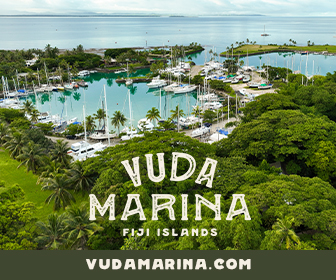French Polynesia, Society Islands: The Beauty and Disappointment
Heading west through the South Pacific, Brent Crack and Mary Bevan report from the Society Islands, both beautiful and at times a little disappointing.
Published 2 years ago
Travelling from the Tuamotus to the Society Islands turned out to have more excitement than we, or any weather forecasting website, could have guessed. We had planned our route for a slight change in wind direction as we approached Tahiti and the knowledge that the winds would be light along the way. Some of the forecast was correct.
Weather warnings on the way
As we sailed closer to Tahiti, we heard warnings on the radio but weren’t positive what the warnings were about because they were in French and very quickly spoken. The warnings sounded to be about a large storm having hit Tahiti with winds to 90 knots. We sent off texts to friends with the satellite phone requesting updates to the weather forecast, but they responded that websites showed no changes. More warnings were broadcasted and we ultimately heard two Mayday calls. One for a sailboat with a broken mast due to large winds and the second with an issue we could not understand.
Satellite texts from friends started to indicate that Tahiti was being hit with high speed wind gusts and that they were not forecast. We were told that the change in weather could be attributed to spin off from cyclones. We were told to get to Tahiti as fast as we could before a second, larger storm hit the area. With contrary winds and significant gusts, we cautiously worked our way into Tahiti and were greeted by a single dolphin while passing the breakwater. It was a relief to be in the calm waters of the harbour.
Tahiti – The first of five stops
A welcome change from the quiet of the Tuamotus, we arrived to spend the first portion of our stay at the marina in downtown Papeete. We were fortunate to arrive in time to obtain one of two remaining open spots in the marina which doesn’t allow for reservations. The gated marina has 24-hour security and a lounge with WiFi, air conditioning and cold showers. There are a few restaurants within walking distance that have happy hours.
Tahiti requires you to check in on arrival. The marina did all the paperwork for us, but we were required to attend the customs office to obtain our duty free fuel certificate. We chose to walk (about 20 mins) to the customs office from the marina, but you can also take a dinghy across. We found that we were able to walk anywhere we needed in Papeete. Groceries and restaurants were all easily accessible.
Papeete’s market has a Sunday early morning farmer’s market. We arrived for 5am and found a great selection. Get there early to avoid queues. Every other day the market still has a decent selection of fruits and vegetables, but the Sunday markets are impressive. Be early as the market is all closed up by about 9 am so locals can go to church. We particularly enjoyed sandwiches that can be purchased there. We had our propane tank refilled at the Mobil gas station which was able to use the North American fittings. If you bring in your propane tank Wednesday morning, it will be available to you Friday at noon for pick up and payment.
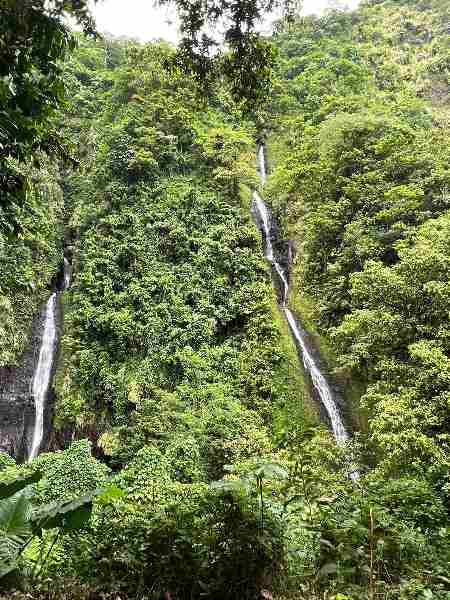
While we found that the marine stores were well stocked, we were on the hunt for fishing lures worthy of replacing the ones we had lost. Our best lures had been stolen by fish far too large to give us a chance in a sailboat, the last of which snapped the line only seconds before it would have been pulled onto the boat.
We are confident that we found the best store for fishing lures in all of French Polynesia – Exocet Distributions (120 Avenue du chef Vairaatoa, Papeete). They upgrade all hooks on pre-made lures and custom build the rest. This family-run shop selected lures and tied them for us with wire in the hope that we won’t lose another. Excellent quality products and great service, we absolutely recommend this store.
Moorea – The most beautiful of the islands
Moorea has tall, steep cliffs and is covered with great walking trails through pineapple plantations and to excellent viewpoints. Maps and trail markers can be found along the way. We took e-bikes around the island and up the hill to Belvedere Point for a total of 70kms.
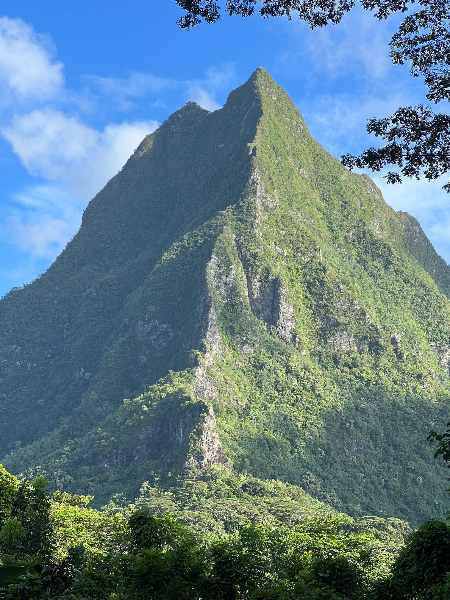
The assisted peddling made the hill climb faster, easier and more enjoyable than if we had walked it. We found that the e-bikes were a really good way of seeing the island. We brought a backpack with us and water. There are good stretches of road without stores or where stores will close for a portion of the day, so bringing water and buying fruit along the way was a good call for us.
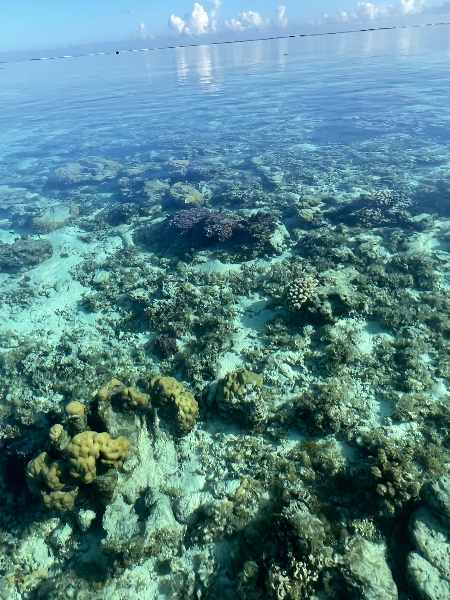
While in Moorea, we also visited the underwater tikis and Stingray City. We left early so that we would be there before too many tour boats started arriving. The underwater tikis were easy to spot from the dinghy once in the area. When we arrived at Stingray City, a few other cruisers were already there. The location has a lot of very friendly stingrays who want to be petted and fed. Black tipped reef sharks are ever present but do not allow you to touch them. By 8 am there were lots of tourist boats arriving and we departed, having enjoyed our morning with the fish.
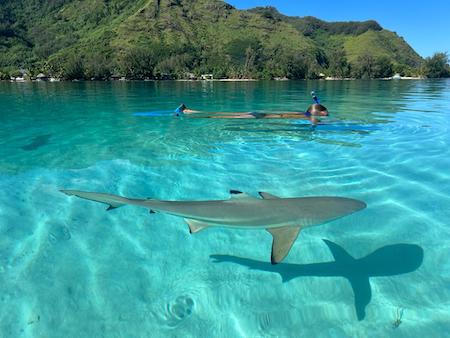

Huahine – The Wild One
We left Moorea for an easy overnight sail to Huahine, advertised as “The Wild One.” On our morning arrival we were fortunate to come in just as other boats were leaving to sail onwards, so we were able to pick up a mooring directly in front of the town of Fare. Most moorings on Huahine are free and there seems to be plenty of them spread down the south-east side of the island. Additionally, there are designated anchoring areas that are in reasonable locations on shallow sand pads without too many bommies and close to attractions
The mooring in front of Fare was ideal for us as it gave access to a free dinghy dock with cheap happy hour drinks at the local yacht club (the cheapest drinks we have seen in FP). As well, a large grocery store and hardware supply store was one block away and beside that a gas station.
Fare also had a selection of small snack shops and restaurants, a market on Sundays (go early, as in 6am early) and free WiFi available at the mayor’s office. We could get the WiFi signal with our booster from the boat. While we found the prices for goods and services higher than most other countries, they were some of the best we had seen in French Polynesia. The selection seemed reasonable with most items available. We took the time to rent an e-bike and circled around Huahine. It was a fun way to see some of the historical sites and explore the area.
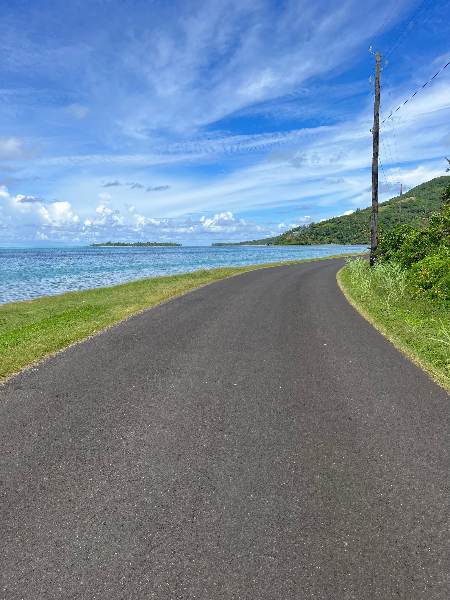
The locals were quite friendly, the scenery was amazing and the e-bikes were fantastic for the few hills. There were grades to 30% but the e-bikes powered us up without much work. It was a good way to see the island.
Huahine is known as “the wild one” and once one is a few kilometres outside of town, there really is not anything for services, so bring some food and water. And if you see some delicious fruit, don’t hesitate to ask a local about picking one – they will probably give you more than you can carry. We also stopped to feed the blue-eyed eels on the bike trip. Bring any canned fish and they will come out of their hiding to eat. Interesting to see. We also did some snorkelling at various spots around the island.
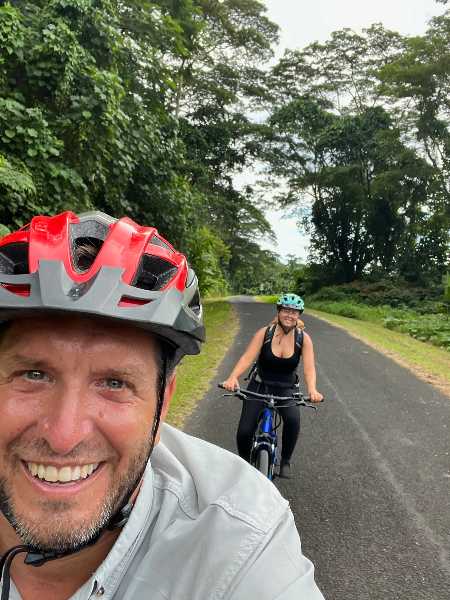
While the water was clear, the coral alive and healthy and the small fish species were abundant, what was readily apparent was the lack of larger fish (other than sharks). The locals are actively spear fishing most days and nights to sell fish to the many resorts and hotels that dot the island.
It is our belief that these activities have negatively impacted most larger fish populations in the lagoon, including parrot fish. One of the hidden harms of tourism. Two good snorkelling spots at these GPS points:
- 16°42.831’S 151°2.712’W
- 16°46.701’S 151°1.910’W
Strong currents
One significant note of caution about the currents in the Huahine lagoon. The current is generally always going out of the lagoon and at times it can absolutely rip. The mooring field in front of Fare is close to the main pass and much of the current goes past at high velocity.
Because the pass is deep, there are no pressure waves and the current is generally not noticeable. There were times that the current was going past the boats in excess of two knots. We saw one lady on a boogie board jump in the water and being unable to swim back to her boat, had to be rescued by a nearby kayaker – something to consider before jumping in the water.
One recommendation to visit – the Huahine Passion Distillery. Everything is made locally, and it is quite a good product with lots of variety. Go with a full stomach as the free samples are numerous.
Tahaa – a ‘get away from the crowds’ destination
The trip from Huahine to Tahaa was an easy half day sail. It’s always nice when you can be in a completely new place in only a few hours. Tahaa and Raiatea are sister islands in one large lagoon.
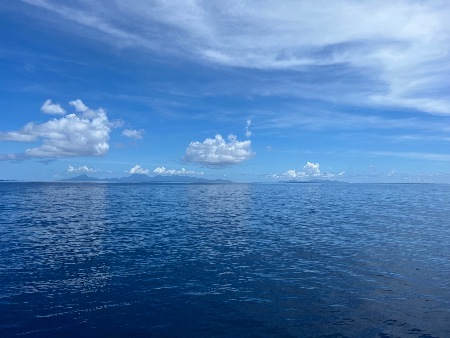

We enjoyed Tahaa so much that we did not go down to Raiatea at all. The anchoring and snorkelling opportunities in Tahaa are endless and the ability to “get away from the crowds” is fantastic. If you are a long term cruiser, you will want to get away from the crowds in this area. There are a number of charter bases nearby and they seem to churn out the clients and boats.
To describe Tahaa from outward to inward – think of a ring with various layers – outer barrier reef with an number of small coral passes that water is continually flowing through, a large sand shelf, with few bommies and depths to 10ft, a coral/bommie zone that has coral coming quite close to the surface at times, deep water and at the center the island of Tahaa. The sand shelf is fantastic for anchoring and gives great access to snorkelling the barrier reef coral channels or the interior coral ring. The trick is that there are some spots that are super easy to cross the coral barrier and others that are tough, requiring attention, a bow watch and good weather. The easterly spots get a lot of charter boats.
The tougher spots are usually where you will find the experienced cruisers and it is here that one can have a little piece of paradise all to yourself. Something to be aware of though – those charter boats see you anchored and will come over to try to get close. One spot we were at – we had at least four different charter boats try to come in because they could see us anchored. We were not on any common anchor spot and they were coming just because they could see us. All four ended up in difficulties with the coral reef and it is likely at least one made contact.
In Tahaa there is a “coral garden” on the west side of the island that is quite popular with tourists. It’s well known and overrun. Skip it. Snorkel any of the other deeper little channels into the lagoon and they will be just as good, in some cases better and you will have them to yourselves. Like Huahine, there is an absence of larger fish, but it is still an impressive snorkel.
Good snorkelling spots:
- 16°33’48″S 151°27’07″W (on google earth, this shows as the coral gardens, but it’s not. Very little traffic here, go early or late in the day and you will have it to yourself)
- 16°33’43″S 151°27’18″W
16°34’58″S 151°26’10″W - 16°38.534’S 151°26.463’W
- 16°36.278’S 151°33.938’W (the popular coral garden spot)
We got some supplies on the west side of Tahaa near the ferry dock. Fuel, distillery, a small magasin (shop), a snack bar and locals selling produce are all available. A slightly larger grocery store with more supplies is located in the next bay to the north. They have a dock that you can tie to. 16°36’01″S 151°32’31″W ·
A final word on the number of charter boats. We moved over to the west side of Tahaa in preparation for a morning departure for Bora Bora. When we arrived, we were the only boat. Four hours later we had 11 boats anchored around us – all charters.
Bora Bora – Must see?
Bora Boring. For many people, Bora Bora is on their list of “must visit” places – it was for us. In hindsight, the reason for the “must visit” for us was completely because of the name and what we had heard about the island in popular culture.
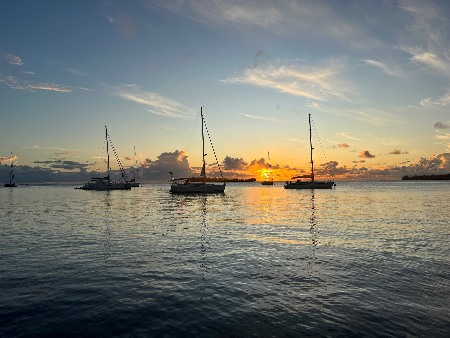

If you are a cruiser and have sailed across the Pacific to here, you have likely stopped at at least five places better than Bora Bora. To us, it is a victim of its own success and has become one of the places that we would not normally visit. Many hotels, many tourists, jetskis and helicopters, all are prevalent.
Friends of ours had visited it just before our arrival and had left early. They advised that it was their “bucket list” place to go but found it boring. Hence the moniker – Bora Boring.
Moorings are mandatory, except for two locations where one is allowed to anchor for 36 hours max and only five boats total. Moorings cost US$40/night. Online information indicates US$20, but reportedly prices went up this year.
The main town Vaitape, is very hectic. A single small street and lots of cars and no sidewalks. Meals out were expensive – US$30 for a basic bacon and egg breakfast. There is a Total Energy fuel dock that any boat can come in to fuel up. Reportedly they give the duty free fuel discount – with the appropriate paperwork.
The positive of Bora Bora – the scenery is impressive with one center pillar mountain and a nice outer lagoon ring. Honestly though, the scenery is not like Moorea, Huahine, or Tahaa, so if you have seen those spots, Bora Bora will underwhelm you.
That’s it for us for French Polynesia. Off to the Cook Islands and then onto New Zealand.
PS: From the Cook Islands:
The people of Rarotonga are so friendly and welcoming. Feels much like Rapa Nui or Pitcairn. Bananas were delivered without being asked for.
However, the yachting facilities/infrastructure absolutely sucks. They are not set up in any way for us. Oh well! We had planned to stay longer but have a weather window straight to New Zealand.
Brent Crack and Mary
SV Knot Safety
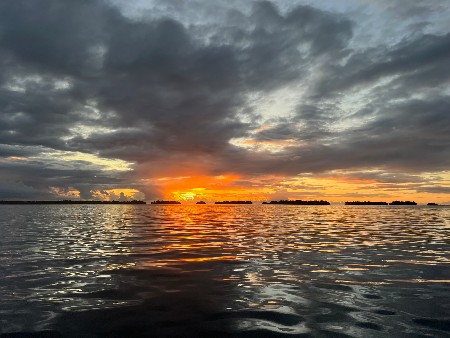

………………………………
About the Authors:
Brent Crack and Mary Bevan are two Canadian citizens who are currently sailing across the South Pacific on a Lagoon 400 catamaran SV Knot Safety, heading for New Zealand.
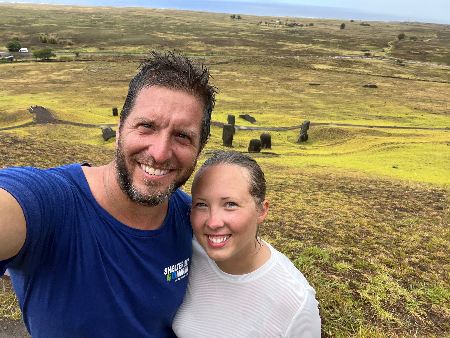
………………………………
The opinions expressed in this article are the author’s own and do not reflect the view of Noonsite.com or World Cruising Club.
………………………………
Other reports from Brent and Mary’s South Pacific Odyssey:
- French Polynesia, Tuamotus: Coral Bombies, Snorkelling and Sharks
- French Polynesia – A Warm Welcome to the Gambiers
- Pitcairn Island – Well Worth the Journey
- Rapa Nui (Easter Island) – Nothing Short of Amazing
See more “Off the Beaten Path” articles and resources here.
………………………………
Find out all news, reports, links and comments posted on Noonsite, plus cruising information from around the world, by subscribing to our FREE monthly newsletter. Go to https://www.noonsite.com/newsletter/.
Related to following destinations: Bora Bora, French Polynesia, Huahine, Moorea, Papeete, Society Islands, Tahaa, Tahiti





